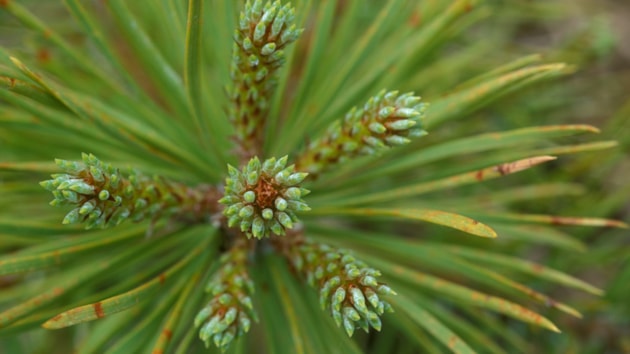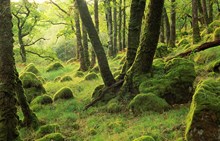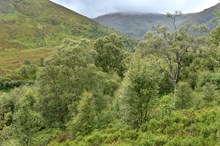21 August, 2024
Scotland's tree gene units branch out

A growing network of specially conserved forests are giving Scotland’s native trees the best chance of responding to climate change and disease – making them fitter for the future.
In 2019, NatureScot’s Beinn Eighe National Nature Reserve in Wester Ross became the UK’s first Gene Conservation Unit (GCU) for Scots pine, recognising the distinctiveness of its ancient Caledonian pine forest.
Now Scotland’s nature agency has registered a further four of its reserves as Gene Conservation Unit sites with the European Forest Genetic Resources Programme (EUFORGEN). This new status recognises the important role the nature reserves play in safeguarding native trees and helping to increase the resilience of Scottish woodlands.
Ariundle, Creag Meagaidh, Glasdrum and Muir of Dinnet National Nature Reserves join Beinn Eighe in conserving the genetic diversity of a range of native trees including alder, aspen, sessile oak, ash, silver birch, rowan, Scots pine and hazel. Genetic diversity is essential for nature’s resilience to pressures such as climate change and diseases, allowing populations to adapt to new pests, pathogens or other pressures.
In total, 20 gene conservation units have now been set up across five NatureScot reserves. Each unit is a clearly mapped areas of forest or woodland where dynamic gene conservation is one of the main management priorities for one or more tree species. This includes looking after the trees to allow and encourage the production of new seedlings and saplings.
Gene Conservation Units are typically located in forests managed for multiple uses, protected areas, or seed stands. Compatible with commercial land use, GCU status is a voluntary accreditation that recognises land managers’ commitment to promoting adaptation to future change through sustainable support of genetic diversity.
NatureScot Woodlands Officer Jeanette Hall said:
“By establishing these new gene conservation units on our nature reserves we’re demonstrating our commitment to carefully monitoring and managing the regeneration of our native trees.
“If there’s plenty of regeneration it’s likely that some of it will be ‘fitter’ for the environment than others, and this enables the population to continue to adapt to changes.
“Our native tree species are hugely important for biodiversity. Aspen, for example, supports nearly 50 species of moth and at least 130 species of lichen, while hazel is a keystone species of Scotland’s rainforest and supports some of our richest communities of lichen and moss. Most populations of ash have at least some trees that are less susceptible to ash dieback, so encouraging its natural regeneration gives it the best chance of resilience to the disease.
“We’re very excited to be expanding the GCU network across our reserves and we are now beginning to work with other public and private land managers to register more units around the country.”
Tom Sim, a scientist at Forest Research who is responsible for registering the UK’s Gene Conservation Units with EUFORGEN, said:
“NatureScot has really taken the initiative in terms of gene conservation of their woodlands and are paving the way for other land managers to recognise and protect genetic diversity of our native tree species.
“The oceanic climate of Scotland is at the northwestern limit of many tree species in Europe. Adaption over many generations to these conditions means that Scottish populations make an important contribution to the genetic diversity of tree species at a continental scale.
“Lots of important research is ongoing to better understand how our native species will respond to climate change and new pests or pathogens. However, if we accept that it is difficult to predict which specific individuals or populations will be best suited to future environmental conditions, it becomes apparent that conserving as much genetic diversity as possible gives us the best chance of passing on these ecosystems to the next generation.
“I hope that the registration of these new GCUs demonstrates the compatibility of gene conservation with other land management objectives and will be a catalyst in recognising a comprehensive network of genetically distinct woodland areas across the UK.”
Contact information
- Name
- NatureScot Media
- Telephone
- 0131 316 2655
- media@nature.scot
Notes to editors
Scotland now has 20 Gene Conservation Units across five sites:
- Ariundle NNR: downy birch, hazel, ash, sessile oak, pedunculate oak, rowan
- Beinn Eighe NNR: Scots pine
- Glasdrum NNR: alder, silver birch, downy birch, hazel, ash, sessile oak, pedunculate oak
- Muir of Dinnet: aspen
- Creag Meagaidh: alder, silver birch, downy birch, rowan and hazel
In 2023, NatureScot, together with the UK Centre for Ecology & Hydrology produced a report that identified 98 potential new sites for gene conservation in Scotland. The report is available at: https://www.nature.scot/doc/naturescot-research-report-1306-pilot-study-find-potential-new-sites-genetic-conservation-units
EUFORGEN – the European Forest Genetic Resources Programme – is an international cooperation programme that promotes the conservation and sustainable use of forest genetic resources in Europe. Experts from member countries come together within EUFORGEN to exchange information and experience, analyse policies and practice, and develop science-based strategies, tools and methods to improve the management of forest genetic resources. For more information see: http://www.euforgen.org/
Forest Research is Great Britain’s principal organisation for forestry and tree-related research and is internationally renowned for the provision of evidence and scientific services in support of sustainable forestry. www.forestresearch.gov.uk @Forest_Research
NatureScot is Scotland's nature agency. We work to enhance our natural environment in Scotland and inspire everyone to care more about it. Our priority is a nature-rich future for Scotland and an effective response to the climate emergency. For more information, visit our website at www.nature.scot or follow us on X at https://x.com/NatureScot
’S e NatureScot buidheann nàdair na h-Alba. Bidh sinn a’ neartachadh àrainneachd na h-Alba agus a’ brosnachadh dhaoine gu barrachd suim a chur ann an nàdar. Tha e mar phrìomhachas againn gum bi nàdar na h-Alba beairteach agus gun dèilig sinn gu h-èifeachdach le èiginn na gnàth-shìde. Tha an tuilleadh fiosrachaidh aig www.nature.scot no air X aig https://x.com/NatureScot






